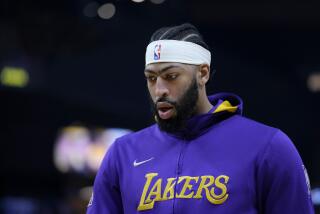It’s Concussion Season Again
- Share via
It’s football season--that time of year when the heads start falling and the concussions start piling up.
Concussion occurs when the brain is jarred or shaken. It is not accompanied by any brain lesion, bleeding or distortion.
Concussion is described more by its symptoms than by any tangible impact on the brain. It usually triggers five or six prominent symptoms, depending on the severity of the blow: loss of consciousness (ranging from seconds to 15 minutes), amnesia of the events just before the blow, vomiting, headaches, giddiness or unsteady gait, and reduced mental performance.
The patient, by all other measurements, appears normal.
Former Rams quarterback Chris Miller, who suffered five concussions in a 15-month span, once stunned a friend when he suddenly announced that he had to rush to catch a plane because “we’re playing Denver tomorrow.” In fact, Miller, who had had a concussion two weeks earlier, wasn’t due to play again for another week.
San Francisco 49ers quarterback Steve Young has suffered three concussions in his last 10 regular season games, the most recent, Aug. 31, at this year’s season opener. His doctors advised him to take a week off, and cleared him to play Sept. 14 after missing one game.
* Grade One concussion usually does not involve a loss of consciousness. But a player should be removed from the game and tested every five minutes until he or she is symptom-free.
* Grade Two can cause a momentary lapse of consciousness. The player should be examined by a doctor, and usually remains out of action for at least two weeks. In no circumstances should the player be allowed to return to the immediate game.
* Grade Three generally features significant memory loss and disorientation. The player should be taken immediately to an emergency room and will probably be out of action for four weeks or more.
The actions that coaches and doctors should take after a player’s concussion were spelled out earlier this year in a report published in the journal of the American Academy of Neurology. Coaches and team doctors can obtain simple exercise and memory tests to administer on the sidelines.
The guidelines have been endorsed by several major sports organizations, such as Pop Warner Football and the National Athletic Trainer Assn. The report was published because of neurologists’ concerns that concussions are not taken seriously enough.
There are few guidelines on what to do after back-to-back concussions. One landmark British study showed that the brains of boxers examined in autopsies bore signs of tiny hemorrhages. Some NFL teams are conducting studies to see if there are “neuropsychological declines” in players who have had concussions.
More to Read
Go beyond the scoreboard
Get the latest on L.A.'s teams in the daily Sports Report newsletter.
You may occasionally receive promotional content from the Los Angeles Times.










